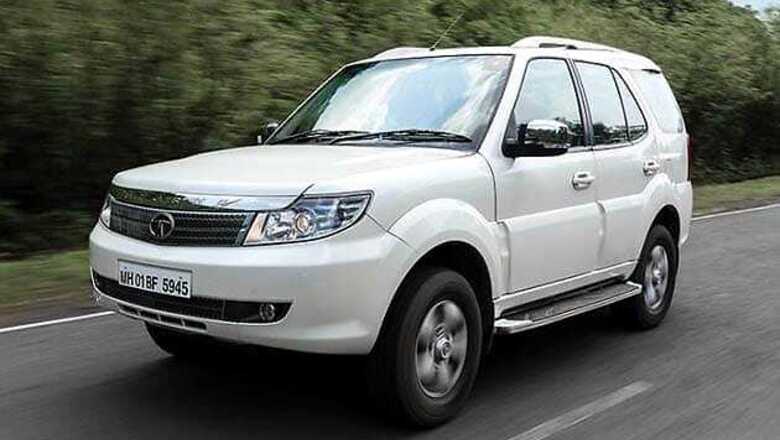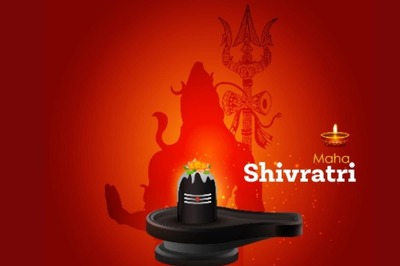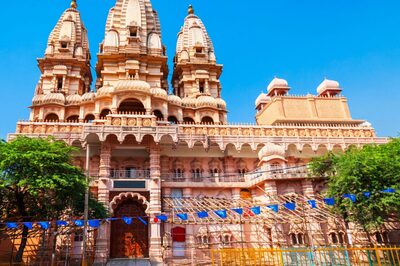
views
It's taken Tata Motors 14 years to give the legendary Safari a new lease of life. So you would expect something truly amazing to happen after such a long gestation period, a cocoon to butterfly metamorphosis type event.
If you look closely at the European automotive manufacturers most of their significant model changes happen just once every ten years, give or take a year, more or less. But when that change happens its almost like a geological shift, the earth moves and a new continent is formed.
Take for instance the Mercedes A-Class, when the model was finally changed some seven years after the older one came about, the change was radical. Gone was the ridiculous MPV-ish character replaced by a hot hatch that oozes sex appeal from every pore. So given time and the will to change, even a duckling turns into the proverbial swan.
When I first saw the next generation Safari, along with the moniker Storme attached to it, at the Auto Expo earlier this year I was a bit taken aback. It did not look like it had seen a blank sheet of paper, rather an eraser and pencil seemed to have been used liberally to remove some of the older lines and draw in new ones.
Yet evaluating its merits wasn't an option at the time since it was still a prototype. Ten months later I was finally satisfying that curiosity, the once legendary SUV was ready for the media to drive and experience.
So 14 years after the original, the new Safari Storme begs the question - has Tata Motors done enough to make it a radically different and better SUV than it ever was?
History
To answer that question I'd like to go a bit back in time to an age where the Safari had little competition. 14 years ago when the Tata Safari was first launched, it was an indigenously designed product and the first true off-road lifestyle vehicle from the Tata stable.
It wasn't however a box office hit instantly, though in time it did attain cult status. It was popular for its mix of off-road abilities, ride comfort and imposing stature. It was definitely one of the best SUVs you could buy in India, a long time ago.
The market boomed, newer and better products were available from a variety of manufacturers and even segment rivals Mahindra got kicking with their Scorpio which turned out to be an even bigger seller than the Safari.
The early Safari was a temperamental beast, often chided for its weak engine, gargantuan weight (in those days power to weight meant little) and on-road dynamics.
Yet it always received credit for its plush ride quality, magnificent seats that were simply superb over long distances and its very capable off-road capabilities thanks to a 4WD transmission with low ratio.
Seven years later it got its first major upgrade with the new DICOR engine, a direct injection turbocharged 3.0-litre diesel. Power output increased but it did little to improve refinement.
Neither did this engine feel linear, the enormous turbo lag was an impediment and the powertrain only got better when the 2.2-litre DICOR was employed a couple of years later. It had a variable geometry turbo and significantly improved performance, efficiency, refinement and power delivery.
Under the hood
This particular engine, the 2.2-litre DICOR which is the best diesel so far from Tata Motors continues to serve the new Safari Storme. Ratings haven't changed, it still makes 140PS with a hugely satisfying 320Nm of max torque available at just 1700rpm.
It's a fairly competent engine where sheer muscle is concerned, though still a bit noisy with enough room to improve on certain factors such as refinement and NVH. Power delivery however is linear, though in urban conditions you'd find yourself shifting down to lower gears more often.
Is there a better option to this engine presently in the market in its segment? No! The Safari's 2.2-litre common rail engine continues to be the most powerful if compared to the Duster (nowhere close) and the Scorpio (somewhere close). Tata Motors claims that this engine returns around 13kmpl in the 4WD variant and around 14kmpl with the 2WD variant.
It's not fantastic efficiency for a diesel and in these troubled times, I would expect a couple more kilometres to be the norm. Yet for a vehicle that still weighs a high 2 tonnes, I can sympathise with the engine still managing to record those figures.
The transmission is still the same 5-speed manual affair with the same electronic shift on the fly 4WD drivetrain. The shift quality isn't the slickest I have experienced, but to put it in perspective, neither does the competition have anything superior.
If anything they are all on the same plane, the stick shift feels a bit elasticky, not entirely precise but with enough smoothness to make any drive a comfortable affair.
Tata Motors is offering two variants of the Storme, the top of the line will have the 4x4 drivetrain (it allows you to shift between 2WD, 4H and 4L) and three more with just 2WD with power delivered straight to the rear wheels only.
Under the skin
The engine and transmission is the only constant in the new Safari Storme, and now that I have gotten past all that's familiar, it's time to step into new territory. The most significant of the new elements is the chassis.
The Safari Storme carries forward its body on frame precedent which in my opinion is required for it to continue to deliver good off-road performance.
It might shift the bias of the Safari Storme more towards off-road abilities rather than on-road dynamics but off the beaten path is where the Safari carved its niche, so full marks for it staying true to that belief.
This entirely new chassis was first used by the Aria but it was designed specifically for a new generation 4x4 SUV, which is the Safari Storme. This chassis is hydroformed, which is an expensive construction process but gives the chassis a greater amount of rigidity and strength than the older chassis.
That strength and rigidity is required to make it a better off-road vehicle, a few more weights tilting the scales in favour of the off-road department though it is also meant to balance out on-road duties.
On a small off-road circuit designed to showcase the several abilities of the Safari Storme, it soon became apparent that this was a very capable 4x4 SUV. But I am not entirely convinced of its angle of approach and departure as well as its wading depth, figures which haven't been released by Tata Motors yet.
On the few obstacles created, the only drawback was the suspension which though independently sprung shows enormous travel. On the severely bumpier patches and the see saw, a hard landing saw the front bumper dive into dirt.
On a few of the other obstacles too, without the right approach and momentum you could very easily scrape the underbelly.
On road the suspension however does not feel too soft so while there is body roll, this is after all still a fairly tall vehicle with an enormous ground clearance and narrow track, the sway is better controlled.
Fantastically, hurtling around a corner in the 4x4 variant did not materialize in any understeer or oversteer, so the 4x4 system works well to distribute torque to all four wheels.
It gives the Safari Storme an air of confidence and assurance that you can still keep things in check. Having said that I do wish the steering was more precise and well balanced, it does need a bit more articulation. Incidentally, on the 4x4 drivetrain the steering feels a lot heavier than in the 2WD variant.
The one critical aspect that stands out tall is the ride quality, this SUV simply smothers anything that comes in its way. It also feels stable and well composed while driving across some of our monsoon ravaged roads without having to slow down.
Even at slow speeds you can barely feel any inconsistencies and the suspension does a marvelous job of ensuring that passenger comfort is maintained at a very high level all the time. It is back to being the benchmark against which several other SUVs will be compared.
The emperor's new clothes
The overall design stays true to the original Safari, you can easily identify the lineage but you'd also notice that the front end is making a valiant effort to look new, polished, upmarket and definitely inspired by its new relation, Land Rover.
That remarkably well defined visual effect is thanks to the new clam shell like bonnet which you can see is clearly inspired by the Freelander 2, Discovery 4 etc. Wrap around headlamps and the grille are much flatter elements and the headlamp assembly has a similar projector style bulb layout to the Land Rovers though visually it does not look as handsome.
The bumper is a new design, it looks larger and sharper and the lower air dam it encloses looks slimmer and wider. That entirely new front end would have made a much more dramatic statement if it had done away with the fine mesh grille and gone in for a bit more statuesque effect like that on the Freelander.
The side profile is very similar to the original, minor details such as the ornamentation on the side mirrors and the outside door handles are new elements. At the rear the door has received some style and detail revisions, but it still opens sideways which in our opinion is a dated approach to accessing the boot.
And the tail gate mounted stepney has moved, it can now be found under the SUV. The overall length has changed minutely because of the new bumpers but otherwise the dimensions stay the same.
The cabin is one area that needed more attention. While Tata Motors has significantly improved the build quality of this cabin, the materials themselves and the overall look and feel isn't what I expected.
Fit and finish for once is superb, and everything looks like it will stay together neatly even after a lot of abuse. But the design of the dashboard, the quality of plastics and the upholstery should have aped the Aria.
The plastics especially look and feel built to a price and taking a cue from a few of the Land Rovers, the Safari Storme should have stayed away from faux wood detailing and gone in for some alternative finish, probably a dull brushed or gun metal finish.
For the first time ever I did not like the seats in the Safari, they lack thigh support and the arm rests for the front passengers feel very flimsy and are not adjustable.
Overall first impression
The Safari Storme is an evolution of the original, but it's a change I would have liked to have seen in 2007 when the DICOR engine was first brought in to serve it.
I for one am left asking a question, what has Tata Motors done with this vehicle over the last 14 years? The opportunity was there for Tata Motors to do with the Safari what Mahindra did in the XUV500 and turn the competition on its head. That isn't the case even though the Safari Storme is a significantly superior vehicle to its predecessors.
The Safari Storme may just inch ahead of the competition but it isn't the game changer it could have been!




















Comments
0 comment